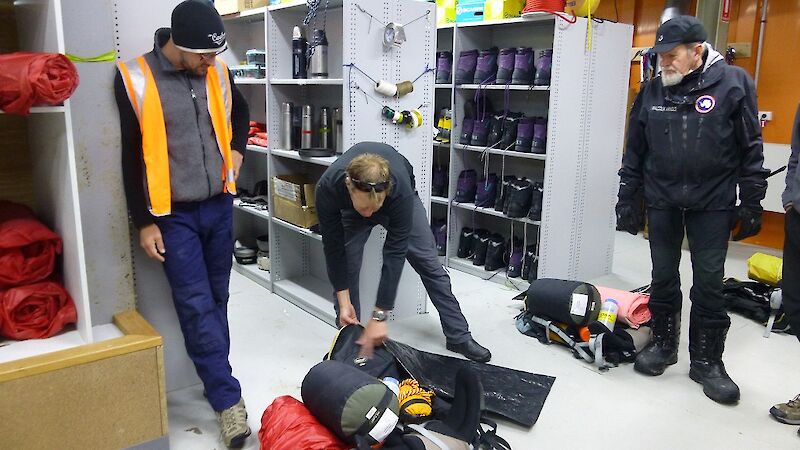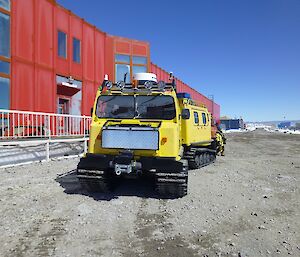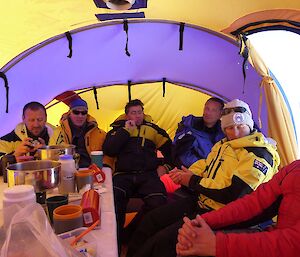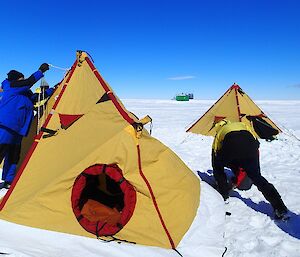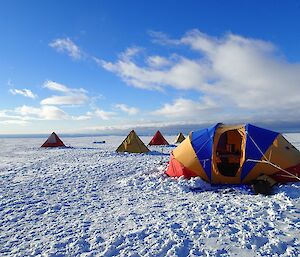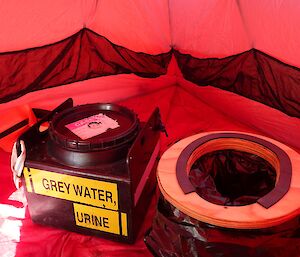The highlight of this week has been field training. The first group of the Aurora Basin field team (Mark, Meredith, Jenny, Jerome, David, Trevor, Simon, Andrew, and me) did our training on Monday and Tuesday.
To get to know each other better we began by introducing ourselves and describing our backgrounds and experiences. We also had to reveal something interesting about ourselves that nobody else in the team knew. There were some funny moments revealing our ‘secrets’, but I won’t give out the details here!
Our Field Training Officer, James, assured us this would not be a boot camp, but an opportunity to work together as a team and to gain some familiarity with our gear and equipment.
Next, we moved to the field shed, which contained all the gear we needed, such as boots, gloves and sleeping bags. We each grabbed a back pack and filled it with a sleeping bag, sleeping mat, throw bag, two pee bottles, and a few hand warmers. With our lunch also packed, we were ready to go.
We travelled in two Hägglands to the Casey skiway, which is about 30 minutes drive from Casey station. We set up the mess tent first and added a table and chairs. It looked like a comfortable dining area, but a little small for 10 people wearing big jackets. We then set up several polar pyramid tents for sleeping.
Some of you might be interested in how we go to the toilet in the field. Of course there is no proper toilet, so we have to use a bucket. After we’d lined the bucket with two black plastic rubbish bags and added a seat, it was ready for the ‘big business’.
The ‘small business’ is much easier for boys. They can use the bottles that are issued individually and empty it into a big bin. For the girls, things are little bit more complicated and nasty. We are issued a special funnel to help us to use the bottles like the boys; standing! Personally, I hate it. But we have no choice… Nature calls me regularly no matter what… but I hate it!
Anyway, back to the field training. After we set up camp we practiced using the GPS. This is a cool piece of equipment. Even if we are lost in the middle of nowhere, it will lead us to the camp site. We won’t get lost, so long as the battery lasts. Viva technology!
We then practiced how to use the stove burner, which is very important if we want to boil water, cook and keep warm. Our wonderful chef, Jenny, had prepared our dinner before we began the training, so all we needed to do was to warm it up. Jenny had prepared fried rice, pasta, beef stew, and lamb shank soup for dinner, followed by several muffins, and chocolate cookies. It’s really nice to have warm food on ice.
Finally, it was time for bed. Even though it was 10 pm, the sun was still up and the sky was bright blue. The weather was beautiful. It was −10 degrees, but it didn’t feel that cold. Because the weather was so nice a few people chose to sleep outside. For me, it was my third time ever sleeping in a tent. I was afraid I would not be able to go to sleep, but I slept very well.
The next morning, we woke around 7 am. After breakfast, we packed up the tents and practiced search and rescue using the GPS and radio. We got into pairs and a ‘commander’ told us where to go via radio. It was hard walking around with big boots on snow, but it was good exercise.
Our last training exercise was a blind walk to prepare us for a scenario of zero visibility. Four to five people were connected in a line with a rope with their eyes covered, and they walked from shed to shed. We could not see anything. The surface wasn’t flat so we walked slowly, communicating with each other. We thought we are walking straight, but somehow we went too far left. I hope we can do better in a real situation; but mostly I hope this situation won’t arise!
It was fun and useful training. Now we know how to erect a polar pyramid, how to build a toilet, and how to sleep in a cold camp. We are all ready to go to Aurora Basin!
My next post will be from the field camp. I hope we have wonderful weather up there.
Mana Inoue is a PhD student at the Antarctic Climate and Ecosystems Cooperate Research Centre and the Institute for Marine and Antarctic Studies at the University of Tasmania. She is working as a field assistant at Aurora Basin, cutting, scraping and analysing ice cores.

